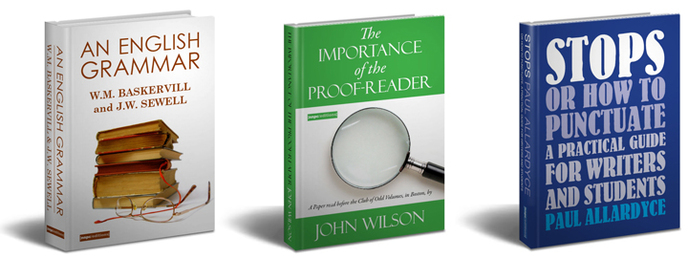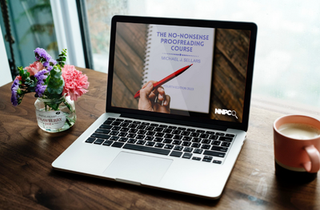|
As an added incentive to purchase The No-Nonsense Proofreading Course (as if any were needed!), I've added three FREE eBooks, totalling more than 340 pages on the subjects of English grammar, punctuation and the importance of the proofreader.
If you've already purchased the course, don't panic! Just drop me a line and I'll send you a link to the free eBooks.
2 Comments
A little interruption to our Proofreading 101 series.
Just to let you know I’ve added a Proofreading Test page to the site. Now, this is a proofreading test with a difference, in that it doesn’t require a red pen, a magnifying glass or a dictionary. In fact, you’ll be surprised to discover that it doesn’t require any reading at all. Intrigued? Well, why not take a look. Click here: proofreading test. Welcome back to Proofreading 101.
Okay, so we know what a proofreader is and what a proofreader does but before we can address the subject of how to become a proofreader (our next post), you probably want to know whether or not it’s worthwhile becoming a proofreader, at all. In other words, you’re asking yourself one of the following questions or a variation thereon: How much do proofreaders charge? How much do proofreaders earn? Is it possible to earn a living as a proofreader? Hopefully, the piece of information below from the Society for Editors and Proofreaders will help. Recommended minimum charges per hour for freelance proofreaders: Proofreading £20.25 ($32.85)* Copy-editing £21.80 ($35.37) On-screen copy-editing £23.65 ($38.37) Substantial editing, rewriting, development editing £27.30 ($44.29) Project management £29.40 ($47.70) *All US Dollar amounts are based on the exchange rate on 11th June 2011. I think that answers your question. Obviously, you can expect to earn less for full-time, permanent positions. This is one of the reasons The No-Nonsense Proofreading Course encourages its readers to pursue the freelance route. The other reason is that, in my experience, the freelance route is one of the best paths to permanent employment. When I was an Operations Manager working in the Publishing Department of one of the UK’s largest mail order and online retailers, every proofreader I interviewed and employed started off as a freelancer. But we’re starting to get into the area of how to become a proofreader, and that’s the subject of our next Proofreading 101 blog post. Until next time... Welcome to the first of my Proofreading 101 blog posts.
So, what exactly does a proofreader do? What precisely is proofreading? In the age of spell checkers and grammar-checking software, do we still need to proofread in the traditional sense? Surely proofreading has gone the way of hot-metal typesetting, book-binding and such. It’s unnecessary, obsolete. It’s (shudder) quaint. Well, if it was a proofreader’s job simply to identify and correct literal spelling errors and obvious grammatical gaffes, then yes, proofreading would no longer be an activity in itself and there would be no need for proofreaders as a professional group. However, proofreaders (the really good ones) don’t just seek out spelling and grammatical inaccuracies. The proofreader’s red pen homes-in on inconsistencies, departures from common sense, inappropriate phrasing (e.g. something very informal in an otherwise business-like document), misleading statements, imprecise use of language, typographical discrepancies, incorrectly captioned images, erroneous telephone numbers, email addresses and URLs. When I worked at Shop Direct, proofreaders checking our mail order catalogues would frequently spot products that were accompanied by the wrong price. Had such errors gone to press, the profit margin of said products would have been significantly reduced. A really great proofreader takes ownership of a document; they ensure that when it hits the press (or is published online) it is absolutely faultless. As for those little spelling errors. Even really exceptional proofreading software, like Whitesmoke or Ginger, struggles when words are spelled correctly but used incorrectly. For example, spell-checking software would find nothing wrong with, ‘The tedious bucket quashed the gangly camcorder,’ even though it makes no sense whatsoever. In short, there really is no substitute for a good pair of eyes and the relentless focus of the proofreader. Maybe one day, there will be a piece of software whose algorithm is so complex and adaptable that we will no longer need proofreaders. But until then... Apologies for the interruption to our Proofreading 101 series but I thought this was a little too important to postpone.
In The No-Nonsense Proofreading Course, there is a chapter entitled From Effective Proofreader to Indispensable Proofreader (It’s Really Not That Far). Okay, so it isn’t the pithiest of chapter headings but it does the job. Anyway, in that particular chapter, you’ll find all kinds of tips that will help you demonstrate to your employer or client that you aren’t just a human grammar- and spell-checker, that you are able to bring to your work a degree of perceptiveness, common sense and rigor that they simply cannot expect from your run-of-the-mill proofreader. I’m currently in the process of creating the third edition of the eBook and have added some information to the aforementioned chapter that I think is too important to keep from you until publication. So, here it is. When proofreading, you will often come across contact information of one sort or another: telephone numbers, email addresses, URLs. The quotidian (what a beautiful word for ‘ordinary’) proofreader will check these for literal errors and obvious deviations from common sense. The indispensable proofreader will call-up the numbers, test out the email addresses to make sure they don’t generate delivery errors and cut and paste URLs into their browser to make sure they actually lead somewhere and not to a 404 or ‘Not Found’ message. It’s little things like this that will elevate you above the competition. So, while your quotidian peers are quibbling over split infinitives, dangling modifiers and hyphenation usage, you will actually be providing your employer or customer with an outstanding 360-degree service. Proofreading 101 will resume shortly. Over the last year or so, I’ve made the mistake that many people blogging about their own field make. I’ve blogged in a linear fashion, assuming the same readership and forgetting that not everyone is necessarily on the same page, so to speak. I’m guilty of leaving newer subscribers to dig about in the cobwebby Archive for the information they’re seeking. The Archive is not a nice place. It’s cold, damp and smells of old umbrellas. Plus, I’m pretty sure there’s something living down there, something with red ink on its fingertips, something that incessantly mutters about split infinitives and dangling modifiers.
So, over the next few posts, I’m going to go back to basics and address some of the fundamentals of proofreading: Why is proofreading important? What is a proofreader? What are proofreader’s symbols (aka proofreader’s marks) and why do we use them? How much do proofreaders get paid? How do I become a proofreader? That kind of thing. Those of you who’ve been following me for some time may want to skip over these posts, but I’d recommend that you don’t. Why? Because sometimes it’s good to remind ourselves of the fundamentals. It’s very easy to suffer mission creep in any area of work, and it’s even easier to pick up a bad habit or two. A little bit of back-to-basics might do you a world of good. It's certainly been helpful for me. Welcome to Proofreading 101. |
Details
Testimonials
“I am one of those many fools who paid a huge amount of money for a useless course. This book... has opened so many doors for me. I now look on Mike as my mentor as I embark on a career. Thank you Mike.” Emma Steel, Proofreader and International Structural Editor. “ I thoroughly enjoyed the course and am so glad that I decided to take it... the whole experience was invaluable. My proofreading service is now well established and your course played no small part in getting it off the ground.” Hache L. Jones, Proofreader. “I'd just like to thank you first of all for writing such a great, straight forward eBook, and then going above and beyond what I would even expect as a customer by providing us, completely free of charge, updated versions months later!” Rachel Gee, Trainee Proofreader. “What can I say? Worth every penny and then some! God Bless! This a fabulous course.” Teresa Richardson, Proofreader. “As someone who has effectively been proofreading for thirty years, I found Mike’s No-Nonsense Proofreading Course an invaluable introduction and a very useful practical guide to many aspects of this discipline. I can wholeheartedly recommend it as the ideal starting point, and much more besides.” Jeremy Meehan, Proofreader. Blog AuthorMy name's Mike Sellars and I'm an experienced proofreader and the author of The No-Nonsense Proofreading Course. Click here to find out more about me. The No-Nonsense Proofreading CourseA Fraction of the Cost of Other Proofreading Courses NOTE: Stock is currently limited to 10 per day, so we can continue to deliver exceptional after-sales service, answer queries and provide open-door support. Credit card and PayPal payments accepted. “As someone who has been proofreading for 30 years, I found Mike’s course an invaluable introduction and a very useful practical guide to many aspects of the discipline. I can wholeheartedly recommend it.” Jeremy Meehan, Proofreader. Still want to find out more? Click here. Proofreading Categories
All
Proofreading Archives
July 2024
|


 RSS Feed
RSS Feed
